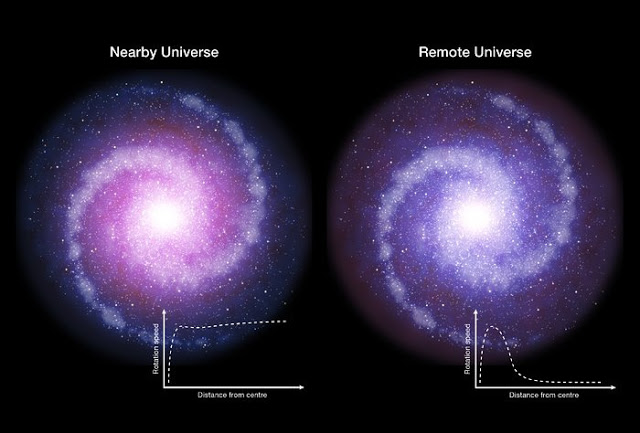

| Online: | |
| Visits: | |
| Stories: |

| Story Views | |
| Now: | |
| Last Hour: | |
| Last 24 Hours: | |
| Total: | |
Dark Matter Shown Less Influential in Galaxies in Early Universe
We see normal matter as brightly shining stars, glowing gas and clouds of dust. But the more elusive dark matter does not emit, absorb or reflect light and can only be observed via its gravitational effects. The presence of dark matter can explain why the outer parts of nearby spiral galaxies rotate more quickly than would be expected if only the normal matter that we can see directly were present.
The disc of a spiral galaxy rotates over a timescale of hundreds of millions of years. Spiral galaxy cores have high concentrations of stars, but the density of bright matter decreases towards their outskirts. If a galaxy’s mass consisted entirely of normal matter, then the sparser outer regions should rotate more slowly than the dense regions at the centre. But observations of nearby spiral galaxies show that their inner and outer parts actually rotate at approximately the same speed. These “flat rotation curves” indicate that spiral galaxies must contain large amounts of non-luminous matter in a dark matter halo surrounding the galactic disc.
Schematic representation of rotating disc galaxies in the early Universe (right) and the present day (left). Observations with ESO’s Very Large Telescope suggest that such massive star-forming disc galaxies in the early Universe were less influenced by dark matter (shown in red), as it was less concentrated. As a result the outer parts of distant galaxies rotate more slowly than comparable regions of galaxies in the local Universe.

Credit: ESO/L. Calçada
New observations from ESO’s Very Large Telescope have revealed that the outer parts of massive disc galaxies 10 billion years ago were rotating less quickly than the spiral galaxies, like the Milky Way, that we see today. This ESOcast Light summarises the important points of this discovery and the significance of dark matter, and how it is distributed.
Both effects seem to become more marked as astronomers look further and further back in time, into the early Universe. This suggests that 3 to 4 billion years after the Big Bang , the gas in galaxies had already efficiently condensed into flat, rotating discs, while the dark matter halos surrounding them were much larger and more spread out. Apparently it took billions of years longer for dark matter to condense as well, so its dominating effect is only seen on the rotation velocities of galaxy discs today
The six galaxies mapped in this study were among a larger sample of a hundred distant, star-forming discs imaged with the KMOS and SINFONI instruments at ESO’s Very Large Telescope at the Paranal Observatory in Chile. In addition to the individual galaxy measurements described above, an average rotation curve was created by combining the weaker signals from the other galaxies. This composite curve also showed the same decreasing velocity trend away from the centres of the galaxies. In addition, two further studies of 240 star forming discs also support these findings.
Detailed modelling shows that while normal matter typically accounts for about half of the total mass of all galaxies on average, it completely dominates the dynamics of galaxies at the highest redshifts.
The data analysed were obtained with the integral field spectrometers KMOS and SINFONI at ESO’s Very Large Telescope in Chile in the framework of the KMOS3D and SINS/zC-SINF surveys. It is the first time that such a comprehensive study of the dynamics of a large number of galaxies spanning the redshift interval from z~0.6 to 2.6, or 5 billion years of cosmic time, has been carried out.
Contacts and sources:
This research was presented in a paper entitled “Strongly baryon dominated disk galaxies at the peak of galaxy formation ten billion years ago”, by R. Genzel et al., to appear in the journal Nature.
Source:


